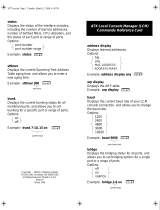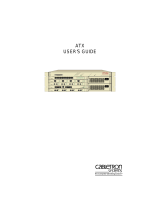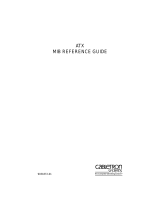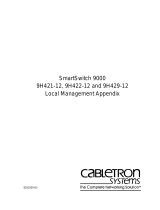Page is loading ...

SmartSTACK 100
ELS100-16TX
USER GUIDE
PWR
CPU
RESET
COM
PORT STATUS MODE
TX ACT FDX MON
RX COL 100 USR
STATUS
ELS100-16TX
EPIM100
EPIM100
10X 12X 14X 16X
9X 11X 13X 15X
2X 4X 6X 8x
1X 3X 5X 7X
LINK
STATUS
LINK
STATUS
2 4 6 8 10 12 14 16
135
7
9111315
9032405-01


i
NOTICE
Cabletron Systems reserves the right to make changes in specifications and other information
contained in this document without prior notice. The reader should in all cases consult Cabletron
Systems to determine whether any such changes have been made.
The hardware, firmware, or software described in this manual is subject to change without notice.
IN NO EVENT SHALL CABLETRON SYSTEMS BE LIABLE FOR ANY INCIDENTAL,
INDIRECT, SPECIAL, OR CONSEQUENTIAL DAMAGES WHATSOEVER (INCLUDING BUT
NOT LIMITED TO LOST PROFITS) ARISING OUT OF OR RELATED TO THIS MANUAL OR
THE INFORMATION CONTAINED IN IT, EVEN IF CABLETRON SYSTEMS HAS BEEN
ADVISED OF, KNOWN, OR SHOULD HAVE KNOWN, THE POSSIBILITY OF SUCH
DAMAGES.
Copyright April 1998 by Cabletron Systems, Inc., P.O. Box 5005, Rochester, NH 03866-5005
All Rights Reserved
Printed in the United States of America
Order Number: 9032405-01
Cabletron Systems
,
SPECTRUM
, and
LANVIEW
are registered trademarks and
SmartSTACK
,
ELS100-16TX
,
ELS10-26TX
,
EPIM-100FX,
FEPIM
,
FEPIM-TX and FEPIM-FX
are trademarks
of Cabletron Systems, Inc.
All other product names mentioned in this manual may be trademarks or registered trademarks of
their respective companies.
FCC NOTICE
This device complies with Part 15 of the FCC rules. Operation is subject to the following two
conditions: (1) this device may not cause harmful interference, and (2) this device must accept any
interference received, including interference that may cause undesired operation.
NOTE:
This equipment has been tested and found to comply with the limits for a Class A digital
device, pursuant to Part 15 of the FCC rules. These limits are designed to provide reasonable
protection against harmful interference when the equipment is operated in a commercial environment.
This equipment uses, generates, and can radiate radio frequency energy and if not installed in
accordance with the operator’s manual, may cause harmful interference to radio communications.
Operation of this equipment in a residential area is likely to cause interference in which case the user
will be required to correct the interference at his own expense.
WARNING:
Changes or modifications made to this device which are not expressly approved by the
party responsible for compliance could void the user’s authority to operate the equipment.
Only qualified personnel should perform installation
procedures.

Notice
ii
DOC NOTICE
This digital apparatus does not exceed the Class A limits for radio noise emissions from digital
apparatus set out in the Radio Interference Regulations of the Canadian Department of
Communications.
Le présent appareil numérique n’émet pas de bruits radioélectriques dépassant les limites applicables
aux appareils numériques de la class A prescrites dans le Règlement sur le brouillage radioélectrique
édicté par le ministère des Communications du Canada.
VCCI NOTICE
This is a Class A product based on the standard of the Voluntary Control Council for Interference by
Information Technology Equipment (VCCI). If this equipment is used in a domestic environment,
radio disturbance may arise. When such trouble occurs, the user may be required to take corrective
actions.
CABLETRON SYSTEMS, INC. PROGRAM LICENSE AGREEMENT
IMPORTANT:
Before utilizing this product, carefully read this License Agreement.
This document is an agreement between you, the end user, and Cabletron Systems, Inc. (“Cabletron”)
that sets forth your rights and obligations with respect to the Cabletron software program (the
“Program”) contained in this package. The Program may be contained in firmware, chips or other
media. BY UTILIZING THE ENCLOSED PRODUCT, YOU ARE AGREEING TO BECOME
BOUND BY THE TERMS OF THIS AGREEMENT, WHICH INCLUDES THE LICENSE AND
THE LIMITATION OF WARRANTY AND DISCLAIMER OF LIABILITY. IF YOU DO NOT
AGREE TO THE TERMS OF THIS AGREEMENT, PROMPTLY RETURN THE UNUSED
PRODUCT TO THE PLACE OF PURCHASE FOR A FULL REFUND.

Notice
iii
CABLETRON SOFTWARE PROGRAM LICENSE
1. LICENSE
. You have the right to use only the one (1) copy of the Program provided in this
package subject to the terms and conditions of this License Agreement.
You may not copy, reproduce or transmit any part of the Program except as permitted by the
Copyright Act of the United States or as authorized in writing by Cabletron.
2. OTHER RESTRICTIONS. You may not reverse engineer, decompile, or disassemble the
Program.
3. APPLICABLE LAW. This License Agreement shall be interpreted and governed under the laws
and in the state and federal courts of New Hampshire. You accept the personal jurisdiction and
venue of the New Hampshire courts.
EXCLUSION OF WARRANTY AND DISCLAIMER OF LIABILITY
1. EXCLUSION OF
WARRANTY. Except as may be specifically provided by Cabletron in
writing, Cabletron makes no warranty, expressed or implied, concerning the Program (including
its documentation and media).
CABLETRON DISCLAIMS ALL WARRANTIES, OTHER THAN THOSE SUPPLIED TO
YOU BY CABLETRON IN WRITING, EITHER EXPRESSED OR IMPLIED, INCLUDING
BUT NOT LIMITED TO IMPLIED WARRANTIES OF MERCHANTABILITY AND
FITNESS FOR A PARTICULAR PURPOSE, WITH RESPECT TO THE PROGRAM, THE
ACCOMPANYING WRITTEN MATERIALS, AND ANY ACCOMPANYING HARDWARE.
2. NO LIABILITY FOR CONSEQUENTIAL DAMAGES. IN NO EVENT SHALL
CABLETRON OR ITS SUPPLIERS BE LIABLE FOR ANY DAMAGES WHATSOEVER
(INCLUDING, WITHOUT LIMITATION, DAMAGES FOR LOSS OF BUSINESS,
PROFITS, BUSINESS INTERRUPTION, LOSS OF BUSINESS INFORMATION, SPECIAL,
INCIDENTAL, CONSEQUENTIAL, OR RELIANCE DAMAGES, OR OTHER LOSS)
ARISING OUT OF THE USE OR INABILITY TO USE THIS CABLETRON PRODUCT,
EVEN IF CABLETRON HAS BEEN ADVISED OF THE POSSIBILITY OF SUCH
DAMAGES. BECAUSE SOME STATES DO NOT ALLOW THE EXCLUSION OR
LIMITATION OF LIABILITY FOR CONSEQUENTIAL OR INCIDENTAL DAMAGES, OR
ON THE DURATION OR LIMITATION OF IMPLIED WARRANTIES, IN SOME
INSTANCES THE ABOVE LIMITATIONS AND EXCLUSIONS MAY NOT APPLY TO
YOU.
UNITED STATES GOVERNMENT RESTRICTED RIGHTS
The enclosed product (a) was developed solely at private expense; (b) contains “restricted computer
software” submitted with restricted rights in accordance with Section 52227-19 (a) through (d) of the
Commercial Computer Software - Restricted Rights Clause and its successors, and (c) in all respects
is proprietary data belonging to Cabletron and/or its suppliers.
For Department of Defense units, the product is licensed with “Restricted Rights” as defined in the
DoD Supplement to the Federal Acquisition Regulations, Section 52.227-7013 (c) (1) (ii) and its
successors, and use, duplication, disclosure by the Government is subject to restrictions as set forth in
subparagraph (c) (1) (ii) of the Rights in Technical Data and Computer Software clause at
252.227-7013. Cabletron Systems, Inc., 35 Industrial Way, Rochester, New Hampshire 03867-0505.

Notice
iv
DECLARATION OF CONFORMITY
Application of Council Directive(s):
89/336/EEC
73/23/EEC
Manufacturer’s Name:
Cabletron Systems, Inc.
Manufacturer’s Address:
35 Industrial Way
PO Box 5005
Rochester, NH 03867
European Representative Name:
Mr. J. Solari
European Representative Address:
Cabletron Systems Limited
Nexus House, Newbury Business Park
London Road, Newbury
Berkshire RG13 2PZ, England
Conformance to Directive(s)/Product Standards:
EC Directive 89/336/EEC
EC Directive 73/23/EEC
EN 55022
EN 50082-1
EN 60950
Equipment Type/Environment:
Networking Equipment, for use in a
Commercial or Light
Industrial
Environment.
We the undersigned, hereby declare, under our sole responsibility, that the equipment packaged
with this notice conforms to the above directives.
Manufacturer Legal Representative in Europe
Mr. Ronald Fotino Mr. J. Solari
___________________________________ ___________________________________
Full Name Full Name
Principal Compliance Engineer Managing Director - E.M.E.A.
___________________________________ ___________________________________
Title Title
Rochester, NH, USA Newbury, Berkshire, England
___________________________________ ___________________________________
Location Location

v
CONTENTS
CHAPTER 1 INTRODUCTION
1.1 ABOUT THIS MANUAL........................................................................1-1
1.2 GETTING HELP.......................................................................................1-2
1.3 DOCUMENT CONVENTIONS.............................................................1-3
1.4 RELATED DOCUMENTATION ...........................................................1-4
1.5 OVERVIEW...............................................................................................1-5
1.5.1 SmartSTACK 100 ELS100-16TX Architecture............................1-6
1.5.2 SmartSTACK 100 ELS100-16TX Bridge Address Table..........1-11
1.5.3 SmartSTACK 100 ELS100-16TX Port Mirroring......................1-12
1.5.4 SmartSTACK 100 ELS100-16TX Sample Applications...........1-12
1.6 LOCAL CONSOLE MANAGER..........................................................1-17
1.6.1 Command Syntax Conventions.................................................1-18
1.6.2 Basic LCM Commands................................................................1-19
CHAPTER 2 UNPACKING AND INSTALLING
YOUR ELS100-16TXTX
2.1 ELS100-16TX FRONT PANEL................................................................2-1
2.2 INSTALLING AN EPIM.........................................................................2-4
2.3 INSTALLING THE ELS100-16TX..........................................................2-6
2.4 CHECKING THE POWER-UP DIAGNOSTICS SEQUENCE...........2-8
2.5 CONNECTING THE LOCAL CONSOLE MANAGER .....................2-8
2.6 CONNECTING TO THE NETWORK...................................................2-9
2.6.1 Connecting UTP Cables..............................................................2-10
2.6.2 Connecting a Segment to the EPIM-100FX ..............................2-11
CHAPTER 3 CONFIGURING YOUR ELS100-16TX
3.1 ASSIGNING IP ADDRESSES.................................................................3-2
3.1.1 Displaying IP Addresses...............................................................3-4
3.1.2 Deleting an IP Address.................................................................3-4
3.1.3 Changing a Subnet Mask..............................................................3-4
3.2 ENABLING BRIDGING..........................................................................3-5
3.3 DISABLING BRIDGING.........................................................................3-6
3.4 DISPLAYING BRIDGING FUNCTIONS .............................................3-6
3.5 ENABLING TRUNKING........................................................................3-7
3.6 DISABLING TRUNKING.....................................................................3-10
3.7 DISPLAYING TRUNKING STATUS..................................................3-11
3.8 ENABLING PORT MIRRORING ........................................................3-13
3.9 DISABLING MIRRORING...................................................................3-13

vi
Contents
3.10 DISPLAYING MIRRORING STATUS ..............................................3-14
3.11 DEFINING AND DELETING WORKGROUPS..............................3-16
3.12 ASSIGNING A COMMUNITY NAME.............................................3-18
3.13 CONFIGURING BROADCAST/MULTICAST STORM
PROTECTION ......................................................................................3-19
3.14 MODIFYING MIB VARIABLES.........................................................3-20
3.15 SYSTEM CONTACT............................................................................3-20
3.16 SYSTEM NAME ...................................................................................3-21
3.16.1 System Location .........................................................................3-21
3.16.2 Community Names....................................................................3-21
3.16.3 Aging Parameter........................................................................3-22
CHAPTER 4 MONITORING AND MANAGING
YOUR ELS100-16TX
4.1 ELS100-16TX MANAGEMENT TOOLS...............................................4-1
4.2 ELS100-16TX STATISTICS......................................................................4-1
4.2.1 Gathering Statistics........................................................................4-2
4.2.2 System Statistics.............................................................................4-2
4.2.3 Ethernet Port Statistics ..................................................................4-3
4.3 USING LCM TO CHECK ELS100-16TX STATUS...............................4-4
4.3.1 Displaying Status...........................................................................4-4
4.3.2 Displaying MAC Addresses.........................................................4-6
4.3.3 Displaying Manufacturing Information.....................................4-8
4.4 MANAGING THE ELS100-16TX...........................................................4-9
4.5 USING LCM TO MANAGE THE ELS100-16TX..................................4-9
4.5.1 Disabling a Port............................................................................4-10
4.5.2 Enabling a Port.............................................................................4-10
4.5.3 Changing a Subnet Mask............................................................4-11
4.5.4 Changing a Community Name..................................................4-12
4.5.5 Setting the Baud Rate ..................................................................4-13
4.5.6 Setting a Reboot Time..................................................................4-14
CHAPTER 5 ELS100-16TX DIAGNOSTICS AND
TROUBLESHOOTING
5.1 POWER-UP DIAGNOSTICS ..................................................................5-1
5.1.1 Power-up LED Sequence ..............................................................5-1
5.1.2 Specific Power-up Tests ................................................................5-2
5.1.3 Software Checksum Comparison................................................5-2
5.1.4 Power-up Diagnostics Results .....................................................5-3

Contents
vii
5.2 RESPONSES TO FAILURES AT POWER-UP......................................5-3
5.3 STATUS AND ACTIVITY INDICATORS............................................5-3
5.4 TROUBLESHOOTING............................................................................5-6
5.5 ELS100-16TX DOES NOT POWER UP.................................................5-6
5.5.1 Connectivity Problems..................................................................5-6
5.5.2 ELS100-16TX Has Rebooted.........................................................5-7
5.5.3 ELS100-16TX Does Not Respond to NMS..................................5-7
APPENDIX A TECHNICAL SPECIFICATIONS
A.1 ELS100-16TX Specifications..................................................................A-1
A.2 Serial Cable Pin Assignments ..............................................................A-3
A.3 100BASE-T Pin Assignments................................................................A-4
A.4 Straight-through Wiring .......................................................................A-5
A.5 Crossover Wiring...................................................................................A-5
A.6 The 5 - 4 - 3 Rule.....................................................................................A-6
A.7 EPIM-100FX Specifications...................................................................A-6
APPENDIX B GLOSSARY

1-1
CHAPTER 1
INTRODUCTION
1.1 ABOUT THIS MANUAL
This manual is for system administrators responsible for
configuring, monitoring, and maintaining the SmartSTACK 100
ELS100-16TX. You should have a familiarity with networking
concepts and principles. In addition, a basic understanding of
SNMP is helpful.
Some SmartSTACK 100 ELS100-16TX configurations can only be
done using an SNMP-based Network Management System (NMS).
Where applicable, this manual provides instructions for using the
Local Console Manager (LCM) to perform basic configuration.
Where it is not possible to use LCM, general instructions and
guidelines applicable to most NMSs are provided.
The contents of each chapter are described below.
• Chapter 1,
Introduction
, outlines the contents of this manual
and provides an overview of the SmartSTACK 100
ELS100-16TX’s switching functions, applications, and the Local
Console Manager (LCM).
• Chapter 2,
Unpacking and Installing Your ELS100-16TX
,
describes the SmartSTACK 100 ELS100-16TX front and rear
panels, how to install the SmartSTACK 100 ELS100-16TX, how to
connect the Local Console Manager (LCM), and how to connect
the ELS100-16TX
to the network.
• Chapter 3,
Configuring Your ELS100-16TX
, provides
instructions for configuring the SmartSTACK 100 ELS100-16TX
using the Local Console Manager (LCM). It also provides some
common Management Information Base (MIB) variables you
may want to change.
• Chapter 4,
Monitoring and Managing Your ELS100-16TX
,
describes how to monitor SmartSTACK 100 ELS100-16TX status
and statistics. It also describes how to manage the SmartSTACK
100 ELS100-16TX Ethernet ports using the Local Console
Manager (LCM).

1-2
Introduction
• Chapter 5,
ELS100-16TX
Diagnostics and Troubleshooting
,
describes the SmartSTACK 100 ELS100-16TX diagnostics and
provides information on troubleshooting common problems.
• Appendix A,
Technical Specifications
, provides the
SmartSTACK 100 ELS100-16TX specifications and basic cabling
pin assignments.
• Appendix B,
Glossary
, provides a glossary of terms both specific
to the SmartSTACK 100 ELS100-16TX and common to the
networking field.
1.2 GETTING HELP
For additional support related to this device or document, contact
the Cabletron Systems Global Call Center:
Before calling the Cabletron Systems Global Call Center, have the
following information ready:
• Your Cabletron Systems service contract number
• A description of the failure
Phone (603) 332-9400
Internet mail suppor[email protected]
FTP ctron.com (134.141.197.25)
Login
anonymous
Password
your email address
BBS (603) 335-3358
Modem setting 8N1: 8 data bits, No parity, 1 stop bit
For additional information about Cabletron Systems or its products, visit the
World Wide Web site:
http://www.cabletron.com/
For technical support, select
Service and Support
.
To send comments or suggestions concerning this document, contact the
Cabletron Systems Technical Writing Department via the following
email address:
Make sure to include the document Part Number in the email message.

Introduction
1-3
• A description of any action(s) already taken to resolve the
problem (e.g., changing mode switches, rebooting the unit, etc.)
• The serial and revision numbers of all involved Cabletron
Systems products in the network
• A description of your network environment (layout, cable type,
etc.)
• Network load and frame size at the time of trouble (if known)
• The device history (i.e., have you returned the device before, is
this a recurring problem, etc.)
• Any previous Return Material Authorization (RMA) numbers
1.3 DOCUMENT CONVENTIONS
The following conventions are used throughout this document:
LCM commands, prompts, and information displayed by the
computer appear in Courier typeface, for example:
Current Number of Learned Addresses: 133
Information that you enter appears in Courier bold typeface, for
example:
ELS100-16 >
status
Information that you need to enter with a command is enclosed in
angle brackets < >. For example, you must enter a port number
and an IP address to execute the
ipaddr <port #> <IP address>
command:
ELS100-16 >
ipaddr 6 192.138.217.40
Field value options appear in bold typeface.

1-4
Introduction
The following conventions are also used in this document:
1.4 RELATED DOCUMENTATION
The following documentation may assist the user in using this
product:
•
Getting Started with the SmartSTACK 100 ELS100-16TX
- contains
the basic information for using the SmartSTACK 100
ELS100-16TX.
•
Interconnections, Bridges and Routers,
Radia Perlman, Addison
Wesley © 1992.
•
Internetworking with TCP/IP: Principles, Protocols, and Architecture
(2nd edition), Volumes I and II, Douglas Comer, Prentice Hall ©
1991.
•
The Simple Book, An Introduction to Management of TCP/IP-based
internets
, Marshall T. Rose, Prentice Hall © Second Edition, 1994.
Note:
Calls the reader’s attention to any item of information that may be
of special importance.
Tip:
Conveys helpful hints concerning procedures or actions.
Caution:
Contains information essential to avoid damage to the
equipment.
Warning:
Warns against an action that could result in equipment
damage, personal injury or death.
Warns against an action that could result in equipment
damage, personal injury or death.

Introduction
1-5
1.5 OVERVIEW
The SmartSTACK 100 ELS100-16TX is an intelligent Ethernet-to-
Ethernet switch that is configured with 16 IEEE 802.3
10/100BASE-T autosensing Ethernet ports. The SmartSTACK 100
ELS100-16TX provides the option of substituting RJ45 ports 15 and
16 (either or both) with two EPIM ports. These ports accept the
EPIM-100FX.
The ELS100-16TX also includes an RS232C port for out-of-band
management. Figure 1-1 shows the front panel for the
SmartSTACK 100 ELS100-16TX.
.
Figure 1-1. SmartSTACK 100 ELS100-16TX Front Panel
The SmartSTACK 100 ELS100-16TX
• Provides dedicated bandwidth for each network connected to
its ports.
• Provides full store and forward bridging functionality and
modified cut through operation.
• Provides complete error checking functionality.
• Provides port trunking to increase bandwidth.
• Provides port mirroring capability for enhanced
troubleshooting.
• Supports Auto-negotiation.
ELS100-16TX Front Panel
PWR
CPU
RESET
COM
PORT STATUS MODE
TX ACT FDX MON
RX COL 100 USR
STATUS
ELS100-16TX
EPIM100
EPIM100
10X 12X 14X 16X
9X 11X 13X 15X
2X 4X 6X 8x
1X 3X 5X 7X
LINK
STATUS
LINK
STATUS
2 4 6 8 10 12 14 16
135
7
9111315

1-6
Introduction
• Operates in either Half Duplex or Full Duplex modes on all
ports.
• Implements the Spanning Tree protocol (802.1d).
• Configured with factory-set defaults for immediate plug-and-
play capability (IP address is not configured at factory).
In addition, the SmartSTACK 100 ELS100-16TX offers the
following features that can help you manage and maintain your
network:
• RMON support.
• Configuration and management using the Simple Network
Management Protocol (SNMP) with either an in-band or out-of-
band connection.
• Protection against broadcast/multicast storms.
• Ability to define virtual workgroups for more efficient
bandwidth usage. The SmartSTACK 100 ELS100-16TX ports can
be segmented into 8 separate broadcast domains.
• Compilation of statistics (by port) for traffic from each user
device connected to a SmartSTACK 100 ELS100-16TX segment.
1.5.1 SmartSTACK 100 ELS100-16TX Architecture
The SmartSTACK ELS100-16TX is a feature rich desktop switch
supporting full wire speed throughput. The SmartSTACK
ELS100-16TX brings enhanced performance and capabilities to
workgroup and departmental networks by allowing the network
administrator to configure the SmartSTACK ELS100-16TX to
operate in a modified cut through mode that increases
performance for larger packets.
The SmartSTACK ELS100-16TX supports 8192 MAC addresses and
is compliant with the IEEE 802.1d Spanning Tree protocol. In
addition, the SmartSTACK ELS100-16TX offers full address
learning and filtering, while protecting against error propagation.

Introduction
1-7
The SmartSTACK ELS100-16TX goes beyond switching basics
incorporating unique management features, including, RMON
statistics and Broadcast/multicast storm protection, proactive
alarms, and both in-band and out-of-band SNMP management.
The SmartSTACK ELS100-16TX uses an ASIC-based switching
engine with the flexibility and performance required for today's
networking demands.
Ethernet switching allows customer to scale bandwidth by
segmenting the network into smaller pieces providing the required
amount of bandwidth to individual users or LAN segments.
Ethernet switching protects the customer’s investment in Ethernet
network hardware by preserving installed shared LAN equipment
such as repeaters and hubs, network interface cards, cabling,
applications, and network operating systems, while re-deploying
high-speed switches where necessary to support today’s
bandwidth demands.
The SmartSTACK ELS100-16TX will operate in either 10 Mbps half
or full duplex or 100 Mbps half or full duplex modes. Utilization of
Fast Ethernet 100 Mbps connections provides a 10 fold increase in
data rate per segment while preserving the basic network
operation and frame format.
The SmartSTACK 100 ELS100-16TX is protocol-transparent,
meaning it can handle different types of network traffic regardless
of the network protocol, such as IP and IPX. As the SmartSTACK
100 ELS100-16TX reads addresses from the packets it processes, it
builds a dynamic database of addresses called the
Bridge Address
Table
. In this way, the SmartSTACK 100 ELS100-16TX continuously
learns the addresses of all connected devices. Consequently, you
can add new devices to the network, change device addresses, and
remove devices from the network without having to reconfigure
the SmartSTACK 100 ELS100-16TX.
The Open System Interconnection (OSI) Reference Model,
developed by the International Standards Organization (ISO),
identifies the levels of functionality inherent in each of its seven
layers. The SmartSTACK 100 ELS100-16TX operates at the Media

1-8
Introduction
Access Control (MAC) sub-layer of the Data Link layer. Figure 1-2
shows the OSI Reference Model.
Figure 1-2. OSI Reference Model
Port Trunking
Another performance enhancing feature of the SmartSTACK
ELS100-16TX is Port Trunking. The SmartSTACK ELS100-16TX
allows two Trunk groups of up to eight 10 Mbps or 100 Mbps ports
to be connected between the SmartSTACK ELS100-16TX and
network devices including Cabletron’s SmartStack 10, FastNET
products and ATX LAN switch. This capability provides a scalable
dedicated bandwidth in a single trunk group of up to 1.6 Gbps
(full duplex) when using 100BaseX ports or 160Mbps (full duplex)
when using the ports in 10BaseT mode. This is accomplished
without introducing any emerging technologies such as Gigabit
Ethernet or ATM. By connecting multiple SmartSTACK ELS100-
16TX products using port trunking, the network administrator can
create a virtual chassis (spanning multiple physical chassis),
providing many-switched Ethernet and Fast Ethernet ports at a
very low cost per port.
Autonegotiation
Auto-negotiation is supported on all of the 16 switched Ethernet
6
Presentation
7
5
4
3
2
1
Application
Session
Transport
Network
Data Link
Physical
ELS100-16TX operates at Layer 2

Introduction
1-9
ports allowing the switch port and an attached device to negotiate
for full or half-duplex modes of operation. The SmartSTACK 100
ELS100-16TX also supports auto-negotiation as defined by IEEE
802.3u and will automatically set the port to the proper mode (10
Mbps, half/full duplex or, 100 Mbps half/full duplex). The
EPIM100-FX interface will not support auto-negotiation, as auto
negotiation for fiber is not defined in the 802.3u specification.
Store and Forward Switching
As an intelligent Ethernet switch, the SmartSTACK 100
ELS100-16TX uses store and forward switching. Store and forward
switching allows the SmartSTACK 100 ELS100-16TX to
temporarily store packets until network resources, typically an
unused link, are available for forwarding. This allows for complete
error checking, and limits the amount of time between when a
device requests access to the network and when it is granted
permission to transmit. In addition, full store and forward
switching ensures data integrity, thus preventing network error
conditions from being generated throughout the network.
Discarding Local Traffic
The SmartSTACK 100 ELS100-16TX checks all incoming packets
for their destination address against the Bridge Address Table. If a
packet’s destination address is not on the same network segment
as the originating packet, the SmartSTACK 100 ELS100-16TX
forwards the packet to the network segment associated with that
destination address, if known. However, if the packet’s source and
destination address are on the same network segment, known as
local traffic
, the packet is automatically discarded (i.e., ignored by
the SmartSTACK 100 ELS100-16TX).
For example, a file transmitted from Workstation A to Workstation
C in Figure 1-3 does not need to leave LAN 1. The SmartSTACK
100 ELS100-16TX connected to LANs 1 and 2 sees all traffic from
LAN 1, including LAN 1 local traffic.

1-10
Introduction
Figure 1-3. Typical Switching Application
By forwarding only packets addressed to devices on other network
segments, the SmartSTACK 100 ELS100-16TX reduces unnecessary
traffic and thereby enhances the overall performance of the
network.
Note:
If the packet address is not found in the Bridge Address Table, it
will be forwarded (flooded) to all network segments.
Spanning Tree Algorithm
The SmartSTACK 100 ELS100-16TX supports the IEEE 802.1d
Spanning Tree algorithm. The Spanning Tree algorithm converts
multiple LANs into a “spanning tree” of networks. It is used to
prevent bridging loops. This standard defines a logical (not
physical) network configuration consisting of one extended LAN
without active duplicate paths between spanning tree bridges.
The SmartSTACK 100 ELS100-16TX, along with other IEEE 802.1d
Spanning Tree compliant bridges in the network, dynamically
configure the network topology into a single Spanning Tree by
exchanging Bridge Protocol Data Units (BPDUs). Typically, each
LAN segment is sent one BPDU every two seconds (this is the
default setting).
When there are multiple SmartSTACK 100 ELS100-16TXs
connecting LANs in a loop, the Spanning Tree algorithm
determines which SmartSTACK 100 ELS100-16TX should forward
LAN 1
LAN 2
ABC
FastNet 10
ELS100-16TX
/











